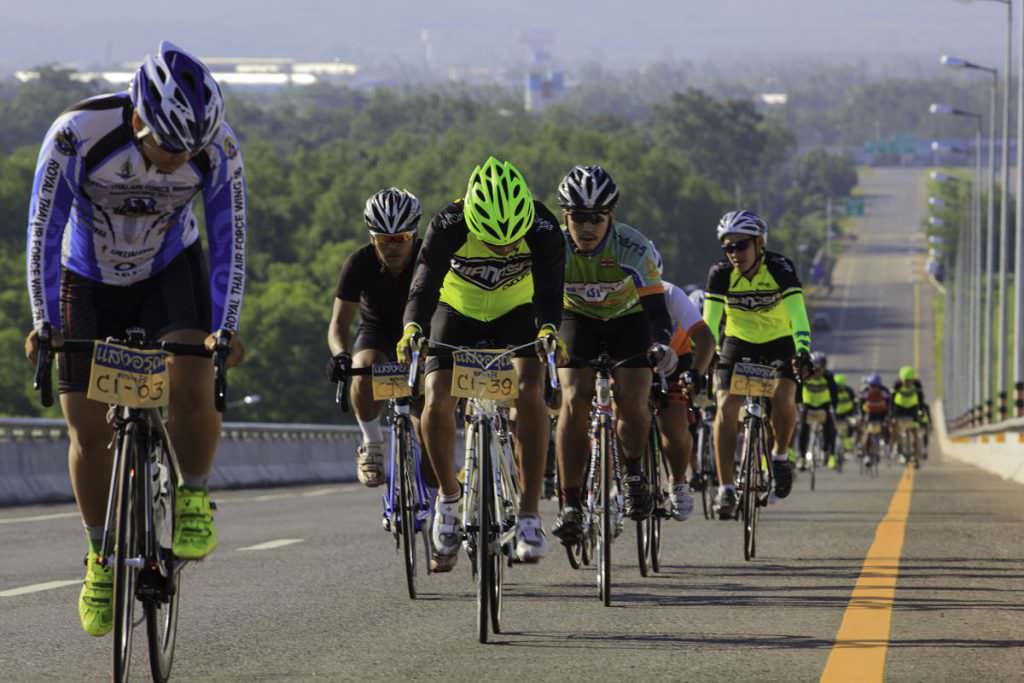Bike fitting and sizing is something we have all had trouble with. Even the best fitters in the world who work with all the best triathletes and professional racers at one time did not know their saddle was too high or their frame too small. Now they use laser levels and special electronics to determine the best bike fit for your anatomy.
Now I know we don’t all have $6000 to go out and get a bike fitting certification and even more money to buy that special equipment so I wanted to give you some quick and easy tips to determine the best fit for your anatomy and maybe even some of your close friends. I will provide fitting guides for different types of bikes as we go so as to give you a better understanding about the differences between types of bikes.
General Anatomy
To begin, everyone is different. Some people have longer torsos and others longer legs so it is important to understand your own anatomy before attempting something like fitting your bike. In fact the greater percentage of people out there are not even genetically symmetrical. Some people have one foot that is longer or one leg that is longer or one ear that is higher or one eye that is lower. Not that facial features matter in bike fitting, but you get the point.
If you are unaware if you have any of these anatomical anomalies the best place to get it checked out is either a physical therapist or a chiropractor. Even slight differences in your anatomy can change the way your body develops muscle on either side of your body. For example, my left leg (more specifically my lower leg below the knee) is longer than my right. When I run, I tend to engage my left quad more so than my right, and in turn my right calf muscle more than my left. It is not enough for me to seek out a fitting or put shims on my pedals but enough for me to know the difference.
Pay attention to the differences as you are attempting to get the best fit from your bicycle.
Road Bikes
Road bikes are traditionally sized by their seat tube dimension. That is the distance from the top of the seat tube to the center of the bottom bracket cup. However that is not the only dimension you should pay attention to when size your bike.
The top tube measurement along with the length of the stem and reach of the handlebars are also important in determine the angle of your back as you are riding. For some riders a long reach will have them hunched over into the bike and thus also being more aerodynamic. For casual riders a less aggressive angle means more miles in the saddle and less pain on the back.
The seat tube is measured in centimeters usually starting on the small end around 46cm and ending in the large end somewhere around 64cm. You can imagine the longer this distance is the longer all the measurements on the frame are going to be as well as bike manufacturers have a pretty good range of frames corresponding with the different sizes of people out there.
Below is a road bike sizing guide. Now, sizing guides are not the be all end all of your bike fit. You might find that a bigger bike fits you better in top tube dimensions or you just the like the aggressive feel of a smaller bike.
My track bike is a 56cm, my touring bike a 54cm and my road bike a 53cm. Different types of bikes have different feels to them based on the different measurements of the tubing.
| Height | Inseam Length | Bike Frame Size | |||
|---|---|---|---|---|---|
| 4’10”-5’1″ | 147-155 cm | 25.5″-27″ | 65-69 cm | 18″-19″ | 46-48 cm |
| 5’0″-5’3″ | 153-160 cm | 26.5″-28″ | 67-71 cm | 19″-20″ | 48-50 cm |
| 5’2″-5’5″ | 158-165 cm | 27.5″-29″ | 70-74 cm | 19.5″-20.5″ | 50-52 cm |
| 5’4″-5’7″ | 163-170 cm | 28.5″-30″ | 72-76 cm | 20.5″-21″ | 52-54 cm |
| 5’6″-5’9″ | 168-175 cm | 29.5″-31″ | 75-79 cm | 21″-22″ | 54-56 cm |
| 5’8″-5’11” | 173-180 cm | 30.5″-32″ | 78-81 cm | 22″-23″ | 56-58 cm |
| 5’10”-6’1″ | 178-186 cm | 31.5″-33″ | 80-84 cm | 22.5″-23.5″ | 58-60 cm |
| 6’0″-6’3″ | 183-191 cm | 32.5″-34″ | 83-86 cm | 23.5″-24.5″ | 60-62 cm |
| 6’2″-6’5″ | 188-196 cm | 34.5″-36″ | 87-91 cm | 24.5″-25.5″ | 62-64 cm |
Some manufacturers have started using small, medium, and large for road bikes as well as changing the road bike geometry by putting in a more sloping top tube like a mountain bike. Sizing conventions like this can accommodate a wider range of riders; all they need is a longer seat post. The Cannondale Synapse and GT Grade are good examples of this. If you ride an extra small you might have to sacrifice the 700c wheels for 650b’s.
Touring Bikes
Let’s talk touring bikes, a close cousin to road bikes and commuters. Many things go into making a bike comfortable for you but first, it starts with the geometry of the frame. Touring bikes often have longer stays (longer wheelbase) because the rider needs to able to carry panniers on the rear rack without clipping them with every pedal revolution. However, if you have longer legs and smaller feet like I do, the long wheel base isn’t necessarily an issue. In fact some people tour on road bikes which have even shorter wheel bases.
You will be putting some serious miles on the bike so you need to imagine yourself being in the saddle for hours at a time and 5 days a week or more. You don’t want to be reaching too far or be hunched over, but at the same time being directly vertical is going to bring all your weight down into your saddle which is hard over long rides.
I like to think I ride with my back at about a 75 degree angle to the ground. The keeps some weight in my hands, makes coming out of the saddle for hills easier, and being mostly upright I have a pretty good understanding of the world around me. However this is completely variable and the reason why you see touring handlebars with multiple positions; so the rider can change hand positions and stretch the back, or sit upright and relieve some pressure.
It is important to feel comfortable so make sure you have your bike dialed in before you get into a habit of riding it with the wrong saddle height, handlebar reach, or cleat placement. Your body adjusts and even the wrong fit bikes can feel comfortable for some time, but beneath the surface it is doing more damage to your muscles, bones, and soft tissues.
A quick story to illustrate my point; my friend got a professional bike fitting for his first major road bike purchase. I’m talking laser levels, ergonomic stationary bikes, video cameras, $800; the whole shebang. Fast forward about 3 years and 1000’s of miles on this bike, he takes it in for a routine seasonal maintenance. After 2-3 short rides, he starts getting major pain in his knee.
Sensing something was up, he takes it back into the shop and finds that one of his pedal clip spacers to raise the height of his clip for his shoes was left off when he picked the bike up. Something as small as few millimeters of space greatly affected how he felt on the bike and ended up sidelining him for 3-4 weeks of recovery.
Cyclocross Bikes
Cyclocross will follow the same conventions as road bikes. You will want a little less aggressive position but not by much because cyclocross is a sprint sport. You have many options, shop around a bit, get the feel for what you think you want and try out some of your friend’s bikes.
Mountain Bikes
Mountain bike sizing conventions are different than road bikes depending on the age of the bike. Pre 2000’s bikes used the same A-frame geometry of road bikes but used a smaller diameter wheel and pulled the bottom brackets further from the ground. They made use of longer cranks to get leverage for those steep climbs and flat handlebars for more side to side control. Old bikes would come in sizes like 16.5 inches, 17.5 inches, 19 inches and 21 inches. It wasn’t until the 2000’s when major manufacturers switched it up to a small, medium, and large convention, did mountain biking and modern technology really take off.
Of course you want to find what is comfortable but think of smalls as for people who are 4’11” to 5’4”, mediums are for those 5’5” to 5’9”, and larges for those 5’10” to 6’3”. There are extra large and extra small frames for those of you on either side but you may have to sacrifice tire size for a comfortable fit. What I mean is someone who is really small may not be able to comfortably ride a 29er.
Mountain bike seating positions are usually less aggressive than road bikes and plus the bike does most of the work so there is no need to be hunched over churning super hard. Your head needs to be up looking for obstacles and dangers. Find a bike you feel comfortable on and make sure you are satisfied before you pay.
Cruisers, Hybrids, or Cross Bikes
These are all different names for basically the same type of bike. Imagine a bike ideal for commuting with an upright position, wider tires, disc brakes and flat handlebars. Most will be sized using the small, medium, and large convention but you may find some outliers. These bikes are often cheap and oddly enough able to fit people more comfortably outside the normal ranges. I work with them and I routinely ride larges and extra larges with no real problems.
I am 5’8” and these bikes should be much too big for me but with the proper saddle height they become just fine. I am not sure if that is a good thing or a bad thing though. Cruisers are more of a one size fits all; you can just get a different seat post and be fine because the bike is not engineered for performance. These bikes are only meant to be ridden a few miles at a time so don’t spend too much time shopping around and not on your bike enjoying the ride.
Kids Bikes
Kid’s bikes are a little harder to size and at times, a little easier. First, some disclaimers; does the fit have to be perfect? No. You are going to spend so much money trading up bikes year after year to try and keep your child on the perfect size bike.
Cycling can be an extremely expensive sport and kids change their minds all the time about what they want to do. I think you should support them in their endeavors but no need to break the bank. A common strategy is just to get things a little bigger and let them grow into it. I see no reason why that strategy shouldn’t work here.
Read also: Kids Bike Size Chart: The Definitive Guide To Kids Bike Sizing
Kid’s bikes are so small, that the measurement you often end up looking at is wheel size. They have bikes with 16in, 18in, 20in, 22in and 24in wheels. If any of these frames seem too small then they might be able to fit a small adult 26in wheel size bike.
I am not sure that someone under 4’11” could comfortably ride a 700c wheel whatever the frame size may be. Keep these things in mind when you are looking and make sure to try out a few options.
Options
Just a few more things to think about; you have options on every part of your bike like I mentioned before, and after market customization can really make the difference in how your bikes feels and how many miles you can put in the saddle.
There are custom frame builders in all countries now. For the absolute best fitting bicycle you could ever have why not go custom? The frame builder will measure your appropriate dimensions and build a bike to fit. Everything will be just right when you pick the specific group set, bars, levers, and cranks. It will be an absolute joy to ride every second. Think about it, if you have the money it is worthwhile investment.
Should you have any questions or require further clarification on the topic, please feel free to connect with our expert author Ryan Ross by leaving a comment below. We value your engagement and are here to assist you.
















6 thoughts on “How to Measure a Bike Frame and Determine Your Bike Size”
this is what i needed. i have a full suspension 21 inch mountain bike but ive been thinking of getting a cruiser/comfort bike but i cant find a 21in frame. now i know it doesnt matter get the biggerst they have at a cheap price and ride it..
One site says I need a frame at 22.5″ yours says 25″ frame…if you look on ebay a 25″ is a kid’s bike…I’m 6’7″ 38″inseam
If I’m 5’3 what has to be the size of my bike?
A diagram that shows the parts of the frame to measure to arrive at a frame size would be really helpful. Still in the dark!!
This is a great post! I have been measuring my bikes for years and this is the best guide I have found.
This is a great post! I have been measuring my bikes for years and this is the best guide I have found.